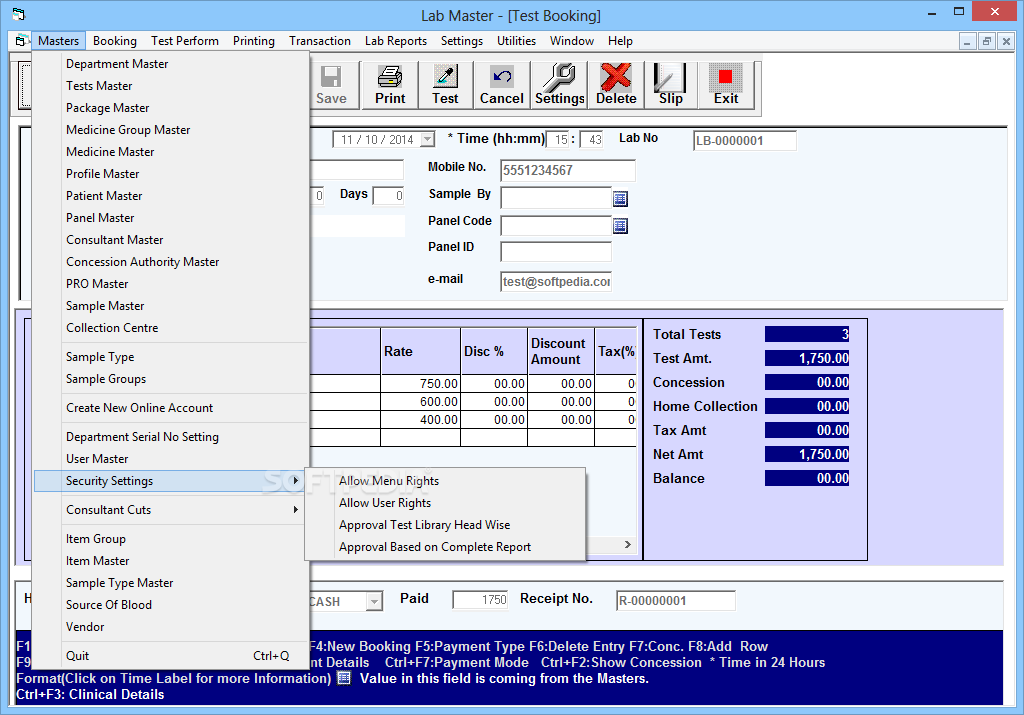

- #MEDICAL LAB SOFTWARE FREE DOWNLOAD MANUAL#
- #MEDICAL LAB SOFTWARE FREE DOWNLOAD PROFESSIONAL#
- #MEDICAL LAB SOFTWARE FREE DOWNLOAD SERIES#
#MEDICAL LAB SOFTWARE FREE DOWNLOAD PROFESSIONAL#
When a blood sample arrives at a lab, a pathologist or a relevant professional registers it along with the patient’s data in the system. Here’s how a lab management software brings in automation in healthcare – 1. It removes the need for manual, repetitive tasks and frees up time and resources for the staff to focus on other matters. For a hospital that sees several dozen patients each day, automation can go a long way in helping the staff ensure the smooth running of day-to-day activities.
#MEDICAL LAB SOFTWARE FREE DOWNLOAD SERIES#
The series of processes mentioned above have to be done the right way. The samples are obtained from patients based on the doctors’ prescription, labeled according to the tests to be performed, prepared the reports, and helped the staff deliver them to the right patient or doctor. Operations at medical labs are all about samples taken from patients. Let’s see how they automate processes.Ī laboratory inventory management solution acts as one comprehensive platform to carry out all the laboratory processes.
#MEDICAL LAB SOFTWARE FREE DOWNLOAD MANUAL#
As the name suggests, automated healthcare solutions remove repetitive manual activities from workflows and enable the software to operate with little to no human intervention. This optimization is often the result of automation. Healthcare software product development has unveiled a range of solutions to streamline medical operations. Just as software has helped optimize operations in pretty much every industry, it has done the same for healthcare. It is prudent to invest in robust clinical laboratory management solutions. To sum it up, a pen and paper-based system slows down things and opens the possibility of errors, increases operational costs, requires a bigger staff, and is ultimately bad for the environment. Using a LIMS platform benefits the laboratory, doctors, and patients. This, in turn, reduces overhead, improves clinical outcomes, and enhances the entire patient experience. Integrated healthcare solutions enable various medical solutions to work together seamlessly at a hospital and optimize operations significantly. On the other hand, laboratory management software almost entirely removes the need for paper.Īnother major disadvantage of using a pen and paper-based system for running medical labs is integration. The use of paper results in deforestation, which reduces carbon absorption from the environment. All of us need to do our bit to save trees, plant more of them, and limit our carbon footprint. Subject matter experts around the globe concur that we are living through another mass extinction event. The planet is in the midst of an environmental catastrophe. The tests could be for blood chemistry, immunology, hematology, toxicology, etc.

It is an excellent platform for doctors to coordinate a wide array of medical testing for patients. Pathologists at laboratories can use it to record, store, and manage all the data relevant to inventory, samples, and testing.

It is one of the many types of software developed to optimize health care management activities. That is where medical lab management software comes into the picture.Ī medical lab management system or laboratory information management system (LIMS) is a kind of software used to manage operations at medical testing laboratories. Collecting the samples, allocating resources, running the tests, generating reports, managing patient data, and handling the financial side require competent operational management and seamless workflows. Needless to point out, ensuring that these tests are completed on time and the reports are delivered to the right patient is paramount. It could be blood glucose testing for diabetics, liver panel or lipid panel tests for assessing liver functions and cardiac risk, tests for thyroid functions, cultures for diagnosing infections, etc. These patients would be prescribed a wide array of tests to detect various diseases. The bigger a hospital gets, the greater the volume of patients it would have to handle. If you’ve ever stepped into the testing laboratory of a large hospital, you would know that managing the lab’s operations alone is no small feat.


 0 kommentar(er)
0 kommentar(er)
